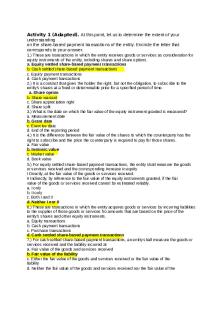Compensation Notes PDF

| Title | Compensation Notes |
|---|---|
| Author | Shane |
| Course | Compensation |
| Institution | Humber College |
| Pages | 2 |
| File Size | 69.6 KB |
| File Type | |
| Total Downloads | 66 |
| Total Views | 175 |
Summary
chapter 1...
Description
Strategic Compensation Chapter 1 – Rewards Anything given by the organization that satisfies one or more of an employee’s needs, is considered a reward. Extrinsic rewards satisfy survival, security, social, and recognition needs. They are external to the work itself and other people control their size and whether they are granted i.e. money, pay raises, bonuses, benefits. Intrinsic rewards satisfy self esteem, achievement, growth, and development needs i.e. praise, recognition, feeling of importance. Incentives are a type of reward that induce valued behaviour. It’s a promise that a specified reward will be given if the employee performs a specified behaviour. It differs from rewards because rewards are to recognize valued behaviour. Compensation only deals with the economic or monetary part of the reward system. Compensation, along with other values such as career advancement opportunities, work/life balance, recognition programs, and a positive workplace culture, is the total rewards approach. Mixing intrinsic rewards with extrinsic rewards, along with the means they are provided, with the objective to motivate behaviour that is necessary to organizational success, is called the reward system. The compensation system is the economic or monetary part of the reward system. A compensation strategy consists of mixing the base pay, performance pay, and indirect pay (benefits) to various categories of employees. The most efficient rewards system (which is not always the cheapest option) is an optimal reward system. Goals of the reward system include promoting achievement, supporting strategy, attract and retaining employees, promoting desired behaviour, equitable, legal, within finances, and doing all this in a cost-effective way.
Chapter 2 An organizations vision refers to its long term, desired state. Its mission is it’s more immediate, present goal. Values refer to an organization’s principles, beliefs, and attitude i.e. teamwork, integrity. Vertical fit is a strategy that aligns strategies at different levels. Horizontal fit aligns strategies at the same level. Classical Managerial Strategy is the managerial strategy that assumes that employees dislike work but can be satisfied via their economic needs. Human Relations Managerial Strategy is the managerial strategy that assumes employees dislike work but can be satisfied via their social needs. High Involvement Managerial Strategy is the managerial strategy that assumes employees dislike work but can be satisfied by being involved and feeling important....
Similar Free PDFs

Compensation Notes
- 2 Pages

Compensation
- 4 Pages

Compensation Midterm Notes
- 21 Pages

Compensation Management
- 197 Pages

Compensation - hhhhhg
- 8 Pages

Damages and Compensation
- 5 Pages

Tort - Claiming compensation
- 7 Pages

Share Based Compensation
- 5 Pages

5 Workers Compensation 2021
- 9 Pages

P2. Imprimer. La compensation
- 5 Pages
Popular Institutions
- Tinajero National High School - Annex
- Politeknik Caltex Riau
- Yokohama City University
- SGT University
- University of Al-Qadisiyah
- Divine Word College of Vigan
- Techniek College Rotterdam
- Universidade de Santiago
- Universiti Teknologi MARA Cawangan Johor Kampus Pasir Gudang
- Poltekkes Kemenkes Yogyakarta
- Baguio City National High School
- Colegio san marcos
- preparatoria uno
- Centro de Bachillerato Tecnológico Industrial y de Servicios No. 107
- Dalian Maritime University
- Quang Trung Secondary School
- Colegio Tecnológico en Informática
- Corporación Regional de Educación Superior
- Grupo CEDVA
- Dar Al Uloom University
- Centro de Estudios Preuniversitarios de la Universidad Nacional de Ingeniería
- 上智大学
- Aakash International School, Nuna Majara
- San Felipe Neri Catholic School
- Kang Chiao International School - New Taipei City
- Misamis Occidental National High School
- Institución Educativa Escuela Normal Juan Ladrilleros
- Kolehiyo ng Pantukan
- Batanes State College
- Instituto Continental
- Sekolah Menengah Kejuruan Kesehatan Kaltara (Tarakan)
- Colegio de La Inmaculada Concepcion - Cebu





